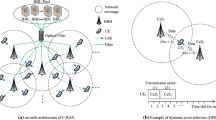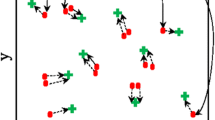Abstract
In cloud radio access networks (C-RAN) for 5G and beyond, the user-centric system model has gained popularity during downlink performance analysis for various reasons like tractability of stochastic geometric approach and distributed beamforming methods. In this paper, the coverage analysis of C-RAN with different distributions of BSs, e.g. uniform, PPP, Matern hard-core point process (MHCPP) of types I, II, and III are studied. We present the coverage analysis with the uniform distribution of BSs and compare it with other deployment distributions of BSs. The effect of threshold distance on the performance of MHCPP distributions is explored. The Monte Carlo simulation of heterogeneous C-RAN with different cluster point processes is observed and compared with the PPP model. The effect of the range of child clusters on the performance analysis is observed in the cluster point processes. To avoid the complexity in the study, interference is not considered in the analysis, and its counterpart simulations are also not considered while performing the comparison.
























Similar content being viewed by others
References
Mobile C. C-RAN: the road towards green ran. White Paper, ver, vol. 2; 2011.
Checko A, Christiansen HL, Yan Y, Scolari L, Kardaras G, Berger MS, Dittmann L. Cloud ran for mobile networks—a technology overview. IEEE Commun Surv Tutor. 2014;17(1):405–26.
Ding Z, Poor HV. The use of spatially random base stations in cloud radio access networks. IEEE Signal Process Lett. 2013;20(11):1138–41.
Yang Z, Ding Z, Fan P. Performance analysis of cloud radio access networks with uniformly distributed base stations. IEEE Trans Veh Technol. 2015;65(1):472–7.
Khan FA, He H, Xue J, Ratnarajah T. Performance analysis of cloud radio access networks with distributed multiple antenna remote radio heads. IEEE Trans Signal Process. 2015;63(18):4784–99.
He H, Xue J, Ratnarajah T, Khan FA, Papadias CB. Modeling and analysis of cloud radio access networks using Matérn hard-core point processes. IEEE Trans Wireless Commun. 2016;15(6):4074–87.
Abana MA, Yaohua S, Ahmed M, Olawoyin LA, Yong L. Performance analysis in cloud radio access networks: user-centralized coordination approach. China Commun. 2015;12(11):1–12.
Peng M, Yan S, Poor HV. Ergodic capacity analysis of remote radio head associations in cloud radio access networks. IEEE Wirel Commun Lett. 2014;3(4):365–8.
Liu X. Closed-form expressions of ergodic capacity in cloud radio access networks with Nakagami-M fading. IEEE Trans Veh Technol. 2017;66(12):11430–4.
Veetil ST, Kuchi K, Ganti RK. Coverage analysis of cloud radio networks with finite clustering. IEEE Trans Wireless Commun. 2017;16(1):594–606.
Haenggi M. Stochastic geometry for wireless networks. Cambridge: Cambridge University Press; 2012.
Jiang X, Zheng F-C. User rate and energy efficiency of Hetnets based on Poisson cluster process. In: 2018 IEEE 87th vehicular technology conference (VTC Spring). New York: IEEE; 2018, pp. 1–5.
Acknowledgements
This study was funded by the Department of Science and Technology (DST), Government of India, under the Grant Nos. DST/ICPS/CLUSTER/IoT/2018/General, Dt. 26-02-2019.
Author information
Authors and Affiliations
Corresponding author
Ethics declarations
Conflict of interest
The authors declare that they have no conflict of interest.
Additional information
Publisher's Note
Springer Nature remains neutral with regard to jurisdictional claims in published maps and institutional affiliations.
This article is part of the topical collection “Emerging Technologies for 5G and Beyond” guest edited by Aloknath De.
Rights and permissions
About this article
Cite this article
Vinnakota, V.B., Sen, D. Performance Analysis of C-RAN with Different Deployment Distributions. SN COMPUT. SCI. 1, 195 (2020). https://doi.org/10.1007/s42979-020-00196-x
Received:
Accepted:
Published:
DOI: https://doi.org/10.1007/s42979-020-00196-x




